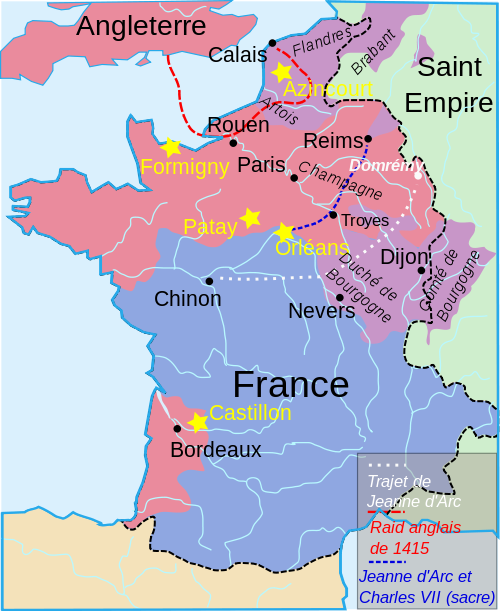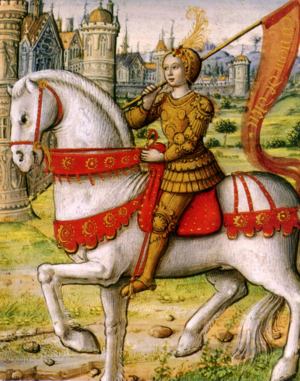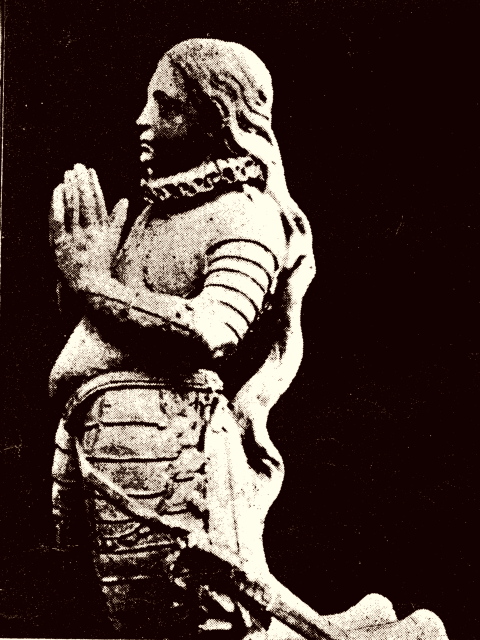Life History of Joan The Maid
Commonly known - Joan of Arc (in French, Jeanne d'Arc)
She was born to Jacques Darc and Isabelle Romée at Domrémy in Lorraine, a northeastern region in France in 1412. Back then, English and French had been fighting for decades (historically called The Hundred Years War). Also, two houses of French royal family the southern Armagnac and the northern Burgundians had been quarrelling in the beginning of 15th century. The powerful Duke of Burgundy of France accused the French heir, Charles the Dauphin, of killing Charles VI and sought alliance with the invading English. When Joan was three, the French was badly defeated by the English at the battle of Agincourt in France. When Joan was nine, both Henry V of England and Charles VI of France died. The English declared Henry VI to be the king for both England and France. The English armies under the Duke of Bedford captured more French territories. So, the dividend nation was besieged by continuous skirmishes and raids by soldiers; Domrémy was burnt in a raid by English and Burgandians. Then an old prophecy surfaced that a maiden from Lorraine would rise to save France from the sufferings. In this dire environment, Joan probably witnessed the horrors of war and turned to seek the advices and guidance by the church.
Map of France1

Joan's family was basically well-to-do, had a large house and some acres of land. Her father Jacques was of peasant class but he had respectful works at this small village. Like most peasant children, she did not learn to read or write, though she received Christian teachings from the Catholic priests. Her daily routines were to help the family with farm and household chores;
the family might have farm horses and she should be familiar with horses (though she said at her trial she protested to the voices that she did not know warfare and riding).
At the age of 13, she heard voices who commanded her to save France from the English and to crown Charles the Dauphin
as the king of France. She believed the voices were those of Saint Michael, Saint Margaret and Saint Catherine. In 1429,
she succeeded to persuade the captain, Sir Robert de Baudricourt at Vaucoulers to send her to see Charles, and took a long journey to Chinon,
passing through the area controlled by the Duke of Burgundy, a rival to the Dauphin. In the journey, her voices led Joan to find a sword in the church of St. Catherine.
In March, Charles was impressed by Joan and permitted the churchmen to examine her at Poitiers.
In April, Joan was given a suit of white armor and a sword to lead an army to city of Orléans which had been successfully blockaded by the English for months.
At that time, Joan allowed herself to be called The Maid or The Maid of Lorraine.
Joan of Arc at horse back2

On April 29, Joan entered Orléans ahead of her army.
On May 6, Joan led the army and captured two smaller forts outside of the city. Next morning,
Joan urged her tired commanders to attack the sturdy fort of Les Tourelles. In the fierce battle, an arrow pierced her shoulder. After her wound was dressed, she returned to urge her retiring troops to go forward again. At the front line with her sword raising high, she encouraged her men to charge.
Seeing her standard, they surged to the walls and entered the fort. The English commander,
Glendale, fell into the ditch outside the tower of the fort and was drowned, as he and some of his men attempted to flee. On May 8, the English abandoned the other forts and retreated; the siege was lifted.
This sudden turn of tidings boosted the morale of French troops and raised the hope of depressed nation.
After that, Joan was also called The Maid of Orléans.
After a few more victories, Charles was crowned as King Charles VII of France with Joan standing beside him in the cathedral of Reims on 17 July 1429.
With a properly crowned and anointed king, the loyalty of territories controlled by the Burgundians began to waver.
The earliest drawing of Joan of Arc3

Joan asked Charles to continue the campaign to free France from the English and to relieve the sufferings of the people. Nevertheless, the apprehensive and timid Charles of meagre means never liked military endeavours and preferred diplomatic solutions, so he began to negotiate with the Burgundians for peace. Without Charles' commitments, she pressed forward nevertheless to continue the campaign.
Her attack of Paris failed; then on 24 May 1430, she was captured by the Burgundians outside the city of Compiegne. Unfortunately Charles did not pay the ransom to free Joan, and the Burgundians sold her to the English.
In a long trial of three months for accusations of sorceries, heresies and other things, she was condemned to die by fire at the stake in Rouen. She died on 30 May 1431. In 1456, she was rehabilitated by Callistus II. Later, she became a national symbol for French. On 18 April 1909, she was beautified by Pius X, and she was canonized by Benedict XV in 1920. Saint Joan of Arc is now France's second patron saint.
Kneeling statue at her home in Domrémy4
Le Ditié de Jehanne d'Arc>
The book of poems Le Ditié de Jehanne d'Arc/The Songs of Joan d'Arc was written by a popular French poet, Christine de Pisan (1364-1430), in July 1429. The poems were inspired by the chain of miraculous events caused by Joan of Arc and were the only French literary work done about Joan during her lifetime.
|
L'an mil quatre cent vingt et neuf Reprit à luire le soleil Il ramène le bon temps neuf Que l'on n'avait vu du droit œil De longtemps, dont plusieurs en deuil En vécurent: je suis de ceux Mais plus de rien je ne me deuil Quand ores vois ce que je veux. |
Year 1429 Came out again the sun. Good times anew came with its shine As long they had not done. Long time did many who were forloin Live through: I was one, But no more at aught now do I pine When I see my want is won. |
| Poem 3 of 61 | (the original text is different from this modern text) |
|---|
Notes
[1] Writing and pronunciation of Joan is quite different in France, where Jeanne (Jehanne and Jehannette, old spellings) means Joan. Maid is pucelle in French; in old French, pucelle means young girl or maiden. In modern French, it often means virgin (female); the word for young boy or lad and male virgin is puceau.
Furthermore, the family name was originally spelled as Darc, but it was changed to d'Arc when Charles VII ennobled the Joan family.
[2] Joan had two swords. One sword was found by Joan in the soil under the altar in the church of St. Catherine of Fierbois. The rusty sword without a sheath had five crosses on it. The priest of the church cleaned off the rust for her and an arm merchant gave her a sheath. The other one was later given to her by The Duke of Alençon.

[3] At her trial, Joan said, "But I loved my banner forty times better than my sword. And when I went against the enemy, I carried my banner myself, lest I kill any. I have never killed a man."
Joan had a standard and a small triangular pennon made by a Scotsman living in Tours, France. A priest designed another small rectangle banner for her to mark her position in the field. The long standard (3 feet by 12 feet) was made of a white material called Buckram and had a silken fringe.
On the standard, God with two angels were painted with a field of lilies, a French symbol; beside the images, Jhesus Maria were painted.
[4] At her trial, she talked about the voices:
At her trial - "When I was thirteen, I had a voice from God to help me to govern myself. The first time, I was terrified.
The voice came to me about noon; it was summer and I was in my father's garden. I saw it many times before I knew it was Saint Michael.
He was not alone, but duly attended by heavenly angels. He told me Saint Catherine and Saint Margaret would come to me, and I must follow their counsel,
that they were appointed to guide and counsel me in what I had to do, and that I must believe what they would tell me, for it was at our Lord's command."
"There is no day that I do not hear the voice. And indeed I need it. I have never asked it for any other reward than, in the end, the salvation of my soul."
"I saw them with the eyes of my body as well as I see you. And when they left me, I wept, and I wished that they might have taken me with them.
And I kissed the ground where they stood, to do them reverence."
In the trial at Rouen and the later rehabilitation trial, there were repetitive enquiries about her voices and the divine appearances. Joan insisted they were from
the Saints. As a matter of facts, she was condemned for death mainly because of her persistent claim of hearing from God. For non-believers, the voices were
from the devils or psychiatric delusions; for others believe otherwise, the voices were indeed of a divine nature.
Nowadays, telepathy and poltergeists are the non-scientific words for her voices. Some modern movies show similar phenomena, for example - the musical "Xanadu" played by Olivia Newton-John.
[5] A French passion - Joan of Arc becomes a national symbol since her tragic death. Many statues have been commissioned and places are named to commemorate her. For example, in Rouen west of the Rue Jeanne d'Arc and Pont Jeanne d'Arc (street & bridge), tourists could promenade around the Vieux Marché (old market) and the southern Place de la Pucelle (square), where there are l'eglise de Jeanne d'Arc (church) and
a museum. Her home village has also been renamed to Domrémy-la-Pucelle.
In cinemas, there are dozens of films about Joan of Arc from 1898 to 2000. Major films released in North America are: 1916 silent movie "Joan the Woman" played by Geraldine Farra; 1948 movie "Joan of Arc" played by Ingrid Bergman; 1999 2-part television series "Joan of Arc" played by Leelee Sobieski; and 1999 film, "The Messenger: The Story of Joan of Arc" played by Milla Jovovich.
Notes on Pictures
1. Source: cartesfrance.fr2. An illustration of 15th century French manuscript.
3. The drawings was made by a French clerk on a page of the register of the Parliament of Paris in May 1429 to record the battle and capture of Orléans on 8 May 1429. (National Archives, Paris).
4. The statue cast in metal has been restored and now placed at Domrémy's house. It is a copy of the stone statue that had been deteriorated, while the stone statue itself could be traced to another statue made in late 14th century or the beginning of 15th century (Picture on a 20th century English book).